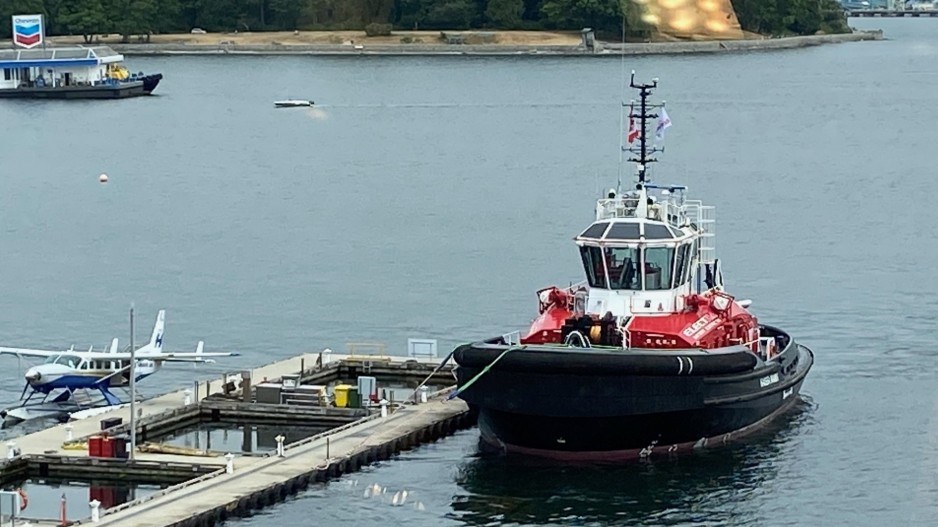First Nations involved in the natural gas and LNG industries in B.C. capitalized on a global LNG conference in Vancouver this week to announce technology and strategies with a decarbonization angles.
HaiSea Marine parked one of its new battery operated tugboats (which will serve the LNG Canada project in Kitimat) at the foot of the west wing of the Vancouver Convention Centre earlier this week, and the Ksi Lisims LNG project announced it had selected Siemens Energy to provide the electric motors for its proposed LNG project in Prince Rupert.
Meanwhile, the First Nations Climate Initiative announced a new international advisory committee that will provide advice on accelerating “Indigenous-led zero-emission LNG and just energy transition solutions.”
HaiSea Marine is a partnership between the Haisla First Nation and Seaspan ULC. Three of five tugboats that will serve the LNG industry in Kitimat are fully battery electric.
They were designed by Vancouver’s Robert Allen marine architects and built in Turkey. They use Corvus Energy batteries. Corvus is the former B.C.-headquartered company that specializes in making marine batteries. It is now headquartered in Norway but still has an office in Richmond. Two of the HaiSea tugs will run on LNG.
One theme heard at the LNG2023 conference this week was how LNG produced in B.C. will have some of the lowest carbon intensities in the world, due in part to electrification.
Earlier this week, the Ksi Lisims LNG project announced that it had awarded Siemens Energy the contract to design and build electric drive turbines for its Prince Rupert LNG project, which is currently moving through the B.C. environmental review process.
Most LNG plants in the world use natural gas powered turbines. Using electric power dramatically lowers the emissions that would be created in the process of chilling natural gas to minus 160 degrees Celsius.
“Designed to connect with B.C.’s renewable hydro-electric power supply, Ksi Lisims LNG’s emissions will be over 90 per cent lower than a conventional LNG facility powered with gas turbines, resulting in one of the lowest carbon intensities of any other LNG export terminal in the world,” Ksi Lisims said in a press release.
“The project is designed to be the largest net-zero LNG export facility in the world. Once operational, Ksi Lisims LNG will produce 12 million tonnes of LNG per year. It is expected to create thousands of jobs, provide substantial financial benefits to the Nisga’a Nation, and to Indigenous nations across B.C.’s northwest.”
The Nisga’a First Nation is a partner in the Ksi Lisims project. The Nisga’a are also members of the First Nations Climate Initiative (FNCI).
The Haisla First Nation and Halfway River First Nation are also members of the FNCI, which is urging both provincial and federal governments to amend their climate change plans to factor in emissions reductions that might occur outside of Canada as a result of using LNG from B.C.
“The FNCI is calling for federal and provincial governments to recognize that Canadian LNG exports play a critical role in global GHG reductions while providing a meaningful pathway for reconciliation—as well as economic and environmental benefits for all British Columbians,” the FNCI said in a news release.
Among its recommendations is that both national and provincial climate plans “include the global reductions that export resources provide through the benchmarking of other jurisdictions.”
In other words, the FNCI is urging government plans to consider not just adding the emissions created when natural gas and LNG are produced in Canada, but also subtracting emissions reductions that may occur in other countries as a result of using Canadian LNG.
“We don’t live in a bubble here on the West Coast,” said Haisla First Nation Chief Crystal Smith. “What happens in Asia happens to us. We must work with Asian countries to help them reduce their GHG emissions while we build our own decarbonized economy. This means providing them with low to zero-carbon alternatives to the energy they currently depend upon.”
The FNCI’s new international advisory committee will be comprised of experts Ira Joseph, global fellow at the Center on Global Energy Policy at Columbia University, Leslie Palti Guzman, co-founder and CEO of Gas Vista LLC, Dave Nikolejsin, strategic advisor for McCarthy Tetrault, Erin Blanton, vice president of Zero Emissions Systems, GTI Energy, and Edward Greenspon, CEO of the Public Policy Forum.
“The First Nations Climate Initiative knows that the net-zero LNG that First Nations projects will export will help other countries to decarbonize their economies,” said Eva Clayton, president of the Nisga’a Nation.
“Many Asian countries still rely on burning coal to generate electricity. To achieve true climate action, we must work together on an international scale. Facilitating the switch from coal to gas is a crucial step in the energy transition globally. But it is not the only step. They can go further and use LNG as a feedstock for manufacturing hydrogen and solid carbon without producing GHGs.”




